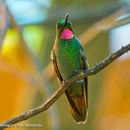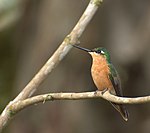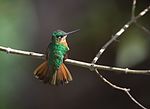pt-BR
nomes no trilho de navegação


Clytolaema rubricauda [2] ye una especie d'ave trochiliforme de la familia Trochilidae endémica del matu atlánticu de Brasil. Ye monotípica dientro del xéneru Clytolaema.[3] Ye común dientro de la so área de distribución y una de les especies reparaes regularmente nos comederos pa páxaros.
Ye un colibrí relativamente grande. El machu ye de color verde col llombu y obispillo cobrizos, la cola ye d'un colloráu cobrizu y el gargüelu ye rubí iridiscente que puede paecer negra dende dellos ángulos. Les femes son de color verde nes partes cimeres y canela nes inferiores. Dambos sexos tienen un llurdiu ocular blanca y el picu negru y rectu.
 Esta páxina forma parte del wikiproyeutu Aves, un esfuerciu collaborativu col fin d'ameyorar y organizar tolos conteníos rellacionaos con esti tema. Visita la páxina d'alderique del proyeutu pa collaborar y facer entrugues o suxerencies.
Esta páxina forma parte del wikiproyeutu Aves, un esfuerciu collaborativu col fin d'ameyorar y organizar tolos conteníos rellacionaos con esti tema. Visita la páxina d'alderique del proyeutu pa collaborar y facer entrugues o suxerencies. Clytolaema rubricauda ye una especie d'ave trochiliforme de la familia Trochilidae endémica del matu atlánticu de Brasil. Ye monotípica dientro del xéneru Clytolaema. Ye común dientro de la so área de distribución y una de les especies reparaes regularmente nos comederos pa páxaros.
Clytolaema rubricauda[1] a zo ur spesad evned eus ar c'herentiad Trochilidae.
Ar spesad nemetañ er genad Clytolaema an hini eo.
Anvet e voe Trochilus rubricauda (kentanv) da gentañ-penn (e 1783)[2] gant an evnoniour izelvroat Pieter Boddaert (1733-1795).
Bevañ a ra diwar sun-bleuñv[3].
Brosezat eo ar spesad e gevred Brazil[4].
a vo kavet e Wikimedia Commons.
Clytolaema rubricauda a zo ur spesad evned eus ar c'herentiad Trochilidae.
Ar spesad nemetañ er genad Clytolaema an hini eo.
Anvet e voe Trochilus rubricauda (kentanv) da gentañ-penn (e 1783) gant an evnoniour izelvroat Pieter Boddaert (1733-1795).
El colibrí cua-roig (Clytolaema rubricauda) és un ocell de la família dels troquílids (Trochilidae) i única espècie del gènere Clytolaema (Gould, 1853).
Boscos i matolls del sud-est de Brasil
El colibrí cua-roig (Clytolaema rubricauda) és un ocell de la família dels troquílids (Trochilidae) i única espècie del gènere Clytolaema (Gould, 1853).
Aderyn a rhywogaeth o adar yw Sïedn gyddfgoch Brasil (sy'n enw gwrywaidd; enw lluosog: sïednod gyddfgoch Brasil) a adnabyddir hefyd gyda'i enw gwyddonol Clytolaema rubricauda; yr enw Saesneg arno yw Brazilian ruby. Mae'n perthyn i deulu'r Sïednod (Lladin: Trochilidae) sydd yn urdd y Apodiformes.[1]
Talfyrir yr enw Lladin yn aml yn C. rubricauda, sef enw'r rhywogaeth.[2] Mae'r rhywogaeth hon i'w chanfod yn Ne America.
Gall fwyta neithdar o fewn blodau, ac wrth ymestyn i'w gyrraedd, mae'n rwbio'n erbyn y paill ac yn ei gario i flodyn arall gan ei ffrwythloni.
Mae'r sïedn gyddfgoch Brasil yn perthyn i deulu'r Sïednod (Lladin: Trochilidae). Dyma rai o aelodau eraill y teulu:
Rhestr Wicidata:
rhywogaeth enw tacson delwedd Seren goed torch biws Myrtis fanny Sïedn cleddbig Ensifera ensifera Sïedn clustfioled brown Colibri delphinae Sïedn clustfioled tinwyn Colibri serrirostris Sïedn cynffonnog coch Sappho sparganurus Sïedn cynffonnog efydd Polyonymus caroli Sïedn dreinbig melynwyrdd Chalcostigma olivaceum Sïedn gên emrallt Abeillia abeillei Sïedn y werddon Rhodopis vesperAderyn a rhywogaeth o adar yw Sïedn gyddfgoch Brasil (sy'n enw gwrywaidd; enw lluosog: sïednod gyddfgoch Brasil) a adnabyddir hefyd gyda'i enw gwyddonol Clytolaema rubricauda; yr enw Saesneg arno yw Brazilian ruby. Mae'n perthyn i deulu'r Sïednod (Lladin: Trochilidae) sydd yn urdd y Apodiformes.
Talfyrir yr enw Lladin yn aml yn C. rubricauda, sef enw'r rhywogaeth. Mae'r rhywogaeth hon i'w chanfod yn Ne America.
Gall fwyta neithdar o fewn blodau, ac wrth ymestyn i'w gyrraedd, mae'n rwbio'n erbyn y paill ac yn ei gario i flodyn arall gan ei ffrwythloni.
Der Rubinkolibri oder Brasilien-Rubinkolibri (Clytolaema rubricauda) ist eine Vogelart aus der Familie der Kolibris (Trochilidae). Er ist die einzige Art der Gattung Clytolaema und lebt endemisch in Brasilien. Der Bestand wird von der IUCN als nicht gefährdet (Least Concern) eingeschätzt. Der Rubinkolibri ist nicht mit dem nordamerikanischen Rubinkehlkolibri identisch.
Der Rubinkolibri erreicht eine Körperlänge von etwa 11,3 cm, wobei die Flügel 7,6 cm, der Schwanz 4,4 cm und der gerade schwarze Schnabel 1,9 cm lang sind. Dabei wiegen die Vögel nur ca. 7 g. Die Kopfseiten, der Nacken und der Vorderrücken, sowie der Bauch des Männchens sind dunkelgrün. Die Stirn und die Brust glitzern stark grasgrün, wobei ein roter Fleck die Kehle ziert. Der Hinterrücken ist goldbronze, die Flügel schwärzlich purpurn. Der rotbraune Schwanz hat bronzegrüne Außensäume an allen Federn. Hinter dem Auge befindet sich ein kleiner weißer Fleck. Die Füße sind dunkelbraun.[1] Gelegentlich kommen melanistische männliche Exemplare vor.[2] Es gibt einen deutlichen Geschlechtsdimorphismus. So ist die Oberseite des Weibchens grün glänzend. Wie die Männchen haben sie postokular einen kleinen weißen Fleck und schwärzlich-purpurne Flügel. Die Unterseite ist hell rotbraun, die Schwanzfedern bronzegrün, wobei die äußeren Paare der Steuerfedern komplett ockerbraun gefärbt sind. Die folgenden Steuerfedern sind ockerfarben mit bronzefarbenen Enden und Außensäumen, sowie einer blassen Endspitze. Schnabel und Beine sind wie beim Männchen gefärbt. Insgesamt sind die Weibchen etwas kleiner.[1]
Ein Ei wiegt ca. 0,74 g bei einer Größe von 16,2 × 10,0 mm. Die Brutzeit ist von November bis März. Die Brutdauer beträgt 15 Tage. Die Jungvögel sind ca. 25 Tage Nesthocker bevor sie das Nest verlassen.[1]
Peter Feinsinger und Robert Knight Colwell haben 1978 fünf verschiedene Rollen für das Zusammenleben von Kolibris definiert. So unterschieden sie zwischen Traplinern an Pflanzen mit hohem Belohnungsgrad[3], Revierverteidiger[3], Traplinern an Pflanzen mit geringem Belohnungsgrad[4], territorialen Parasiten bzw. Eindringlingen und Generalisten.[4] Die männlichen Rubinkolibris werden in die Gruppe der Territorialisten eingeordnet, d. h., sie verteidigen ihr Revier aggressiv gegen Artgenossen und andere Kolibriarten. Gelegentlich plündern sie ein Revier, welches von Weißkehlkolibris (Leucochloris albicollis) (Vieillot , 1818) verteidigt wird. Sind nicht ausreichend Nahrungsressourcen vorhanden, agieren sie auch als Generalisten. Aufgrund ihres hohen Energiebedarfs fliegen sie dann auch weit verstreute Blütenkronen an und nehmen gelegentlich auch Nektar von stiellosen Pflanzen auf. Die Weibchen gelten als Generalisten und sind weniger territorial.[5]
Zu den Pflanzen, die der Rubinkolibri anfliegt, gehören die zu den Hülsenfrüchtlern gehörende Gattung Inga, die zu den Riemenblumengewächsen gehörende Gattung Psittacanthus, die zu den Gesneriengewächsen gehörende Art Mendoncia coccinea, Passionsblumen und die zu den Pfeilwurzgewächsen gehörende Art Stromanthe sanguinea. Insekten fangen die Vögel im Flug, indem sie, von einem Ast abfliegend, kurze Jagdausflüge machen und auf den gleichen oder einen anderen Ast zurückkehren.[6]
Das Verbreitungsgebiet erstreckt sich über den Südosten Brasiliens. Hier findet man sie vom Bundesstaat Goiás über Minas Gerais bis nach Rio Grande do Sul.[7] Hier halten sich die Vögel gerne in Wäldern mit Araukarien, Gebüsch, Plantagen und Parks auf.[2]
Ihre Stimme klingt wie jig, jig, jig, wobei das im Gesang in ein jüg chrrrrr, jüg cherrrr, jüg chrrrr übergeht.[1] Da der Flügelschlag vom Rubinkolibri sehr schnell ist, klingt er wie eine Hummel.
Pieter Boddaert beschrieb den Kolibri unter dem Namen Trochilus rubricauda. Einen Fundort nannte er nicht.[8] Es war John Gould, der ihn in der Lieferung 6 seiner Kolibritafeln 1853 in die neue Gattung Clytolaema einordnete.[9][10] Dieser Name ist griechischen Ursprungs und leitet sich von »klutos, κλυτος« für »glorreich, prächtig« und »laimos, λαιμος« für »Hals, Kehle« ab.[11] Das Artepitheton »rubricauda« ist aus dem lateinischen Worten »ruber, rubra« für »rot« und »cauda, χλωρος« für »Schwanz« abzuleiten.[12]
Der Rubinkolibri oder Brasilien-Rubinkolibri (Clytolaema rubricauda) ist eine Vogelart aus der Familie der Kolibris (Trochilidae). Er ist die einzige Art der Gattung Clytolaema und lebt endemisch in Brasilien. Der Bestand wird von der IUCN als nicht gefährdet (Least Concern) eingeschätzt. Der Rubinkolibri ist nicht mit dem nordamerikanischen Rubinkehlkolibri identisch.
The Brazilian ruby (Heliodoxa rubricauda) is a species of hummingbird in the "brilliants", tribe Heliantheini in subfamily Lesbiinae. It is endemic to Brazil.[3][4]
The Brazilian ruby was described by the French polymath Georges-Louis Leclerc, Comte de Buffon in 1780 in his Histoire Naturelle des Oiseaux.[5] The bird was also illustrated in a hand-colored plate engraved by François-Nicolas Martinet in the Planches Enluminées D'Histoire Naturelle which was produced under the supervision of Edme-Louis Daubenton to accompany Buffon's text.[6] Neither the plate caption nor Buffon's description included a scientific name but in 1783 the Dutch naturalist Pieter Boddaert coined the binomial name Trochilus rubicauda in his catalogue of the Planches Enluminées.[7] The type locality is Rio de Janeiro in Brazil.[8]
The Brazilian ruby was at one time the only species in the genus Clytolaema that was introduced by the ornithologist and bird artist John Gould in 1853.[9] However, a 2014 publication provided evidence that Clytolaema is embedded within genus Heliodoxa. The South American Classification Committee of the American Ornithological Society (SACC) and the International Ornithological Committee (IOC) adopted the change in mid-2022.[10][3] As of that date the Clements taxonomy and BirdLife International's Handbook of the Birds of the World retained it in Clytolaema.[11][12]
The Brazilian ruby's earlier generic name Clytolaema combined the Ancient Greek klutos meaning "glorious" and laimos meaning "throat". The specific epithet rubricauda combines the Latin ruber meaning "red" and cauda meaning "tail".[13]
The Brazilian ruby is monotypic.[3]
The Brazilian ruby is 10.8 to 11.3 cm (4.3 to 4.4 in) long. Males weigh 7 to 9.2 g (0.25 to 0.32 oz) and females 5.9 to 7.1 g (0.21 to 0.25 oz). Both sexes have a medium length black bill and a white spot behind the eye. Adult males have an iridescent emerald green forehead and crown, a green nape, and a golden bronze back and rump. The chin is blackish, the gorget shining ruby red, the breast iridescent emerald green, and the belly dark gray with green speckles. The central tail feathers are golden bronze and the rest rufous with bronze edges. Adult females have a grass green crown and back and a cinnamon rump. Their underparts are entirely cinnamon. Their tail is like the male's. Juveniles are like females with the addition of buff fringes on the head feathers. Melanistic morph individuals are frequent.[14]
The Brazilian ruby is found in eastern and southeastern Brazil from Bahia south to Rio Grande do Sul. It inhabits the interior of forest, scrublands, parks, and banana plantations, and is frequently seen at feeders. In elevation it is most numerous below 500 m (1,600 ft) but ranges as high as 1,500 m (4,900 ft).[14]
The Brazilian ruby is mostly sedentary but locally makes some seasonal elevational movements.[14]
The Brazilian ruby feeds on nectar from a wide variety of flowering plants and trees, both native and introduced. Males often defend feeding territories and females sometimes do. They also capture small insects by hawking from a perch.[14]
The Brazilian ruby's breeding season spans from November to March. It makes a cup nest of soft plant material with lichen on the outside and places it on a horizontal branch, typically 3 to 10 m (10 to 30 ft) above the ground. The female incubates the clutch of two eggs for 15 to 16 days; fledging occurs about 25 days after hatch.[14]
The Brazilian ruby's song is described as "jig chrrrrrr....jig cherrrrrr...jig chrrrrrr". It also makes a "jig jig jig" call.[14]
The IUCN has assessed the Brazilian ruby as being of Least Concern. Though it has a large range, its population size and trend are unknown. No immediate threats have been identified.[1] It occurs in several protected areas, and is "[c]ommon throughout [its] range...and readily accepts man-made habitats like tree-filled gardens, parks and plantations."[14]
The Brazilian ruby (Heliodoxa rubricauda) is a species of hummingbird in the "brilliants", tribe Heliantheini in subfamily Lesbiinae. It is endemic to Brazil.
El colibrí colirrojo[2] o colibrí grande de cuello rosado (Clytolaema rubricauda) [3] es una especie de ave trochiliforme de la familia Trochilidae endémica de la mata atlántica de Brasil. Es monotípica dentro del género Clytolaema.[4] Es común dentro de su área de distribución y una de las especies observadas regularmente en los comederos para pájaros.
Es un colibrí relativamente grande. El macho es de color verde con la espalda y obispillo cobrizos, la cola es de un rojo cobrizo y la garganta es rubí iridiscente que puede parecer negra desde algunos ángulos. Las hembras son de color verde en las partes superiores y canela en las inferiores. Ambos sexos tienen una mancha ocular blanca y el pico negro y recto.
El colibrí colirrojo o colibrí grande de cuello rosado (Clytolaema rubricauda) es una especie de ave trochiliforme de la familia Trochilidae endémica de la mata atlántica de Brasil. Es monotípica dentro del género Clytolaema. Es común dentro de su área de distribución y una de las especies observadas regularmente en los comederos para pájaros.
Clytolaema rubricauda Clytolaema generoko animalia da. Hegaztien barruko Trochilidae familian sailkatua dago.
Clytolaema rubricauda Clytolaema generoko animalia da. Hegaztien barruko Trochilidae familian sailkatua dago.
Rubiinikolibri (Clytolaema rubricauda) on Brasilian kotoperäinen kiitäjälintu, ja sukunsa Clytolaema ainoa laji. Sen esiintymisalue käsittää maan itäosan Goiásista Rio Grande do Suliin. Pieter Boddaert kuvaili lajin holotyypin Rio de Janeirosta vuonna 1783.[2]
Rubiinikolibri (Clytolaema rubricauda) on Brasilian kotoperäinen kiitäjälintu, ja sukunsa Clytolaema ainoa laji. Sen esiintymisalue käsittää maan itäosan Goiásista Rio Grande do Suliin. Pieter Boddaert kuvaili lajin holotyypin Rio de Janeirosta vuonna 1783.
Clytolaema rubricauda
Le Colibri rubis-émeraude (Clytolaema rubricauda) est une espèce de colibris endémique du Brésil. D'après Alan P. Peterson, c'est une espèce monotypique, et c'est la seule espèce du genre Clytolaema.
Ses habitats sont les forêts tropicales et subtropicales humides de montagne, la végétation tropicale et subtropicale humide de broussailles. On la trouve aussi sur les sites d'anciennes forêts lourdement dégradées, les plantations, les jardins ruraux et dans diverses autres zones urbaines.
La population d'oiseau n'a pas été quantifiée, mais cette espèce est décrite comme plutôt commune.
Clytolaema rubricauda
Le Colibri rubis-émeraude (Clytolaema rubricauda) est une espèce de colibris endémique du Brésil. D'après Alan P. Peterson, c'est une espèce monotypique, et c'est la seule espèce du genre Clytolaema.
Il colibrì rubino del Brasile (Clytolaema rubricauda (Boddaert, 1783)) è un uccello della famiglia Trochilidae. È l'unica specie nota del genere Clytolaema.[2]
È un colibrì di media taglia, lungo 10,8–11,3 cm; i maschi pesano 7–9,2 g, le femmine 5,9–7,1 g.[3]
Si nutre del nettare di diverse specie di angiosperme tra cui Helicteris spp., Dombeya spp., Citrus spp.[3]
La specie è diffusa nella Foresta atlantica del Brasile meridionale.[1]
Il colibrì rubino del Brasile (Clytolaema rubricauda (Boddaert, 1783)) è un uccello della famiglia Trochilidae. È l'unica specie nota del genere Clytolaema.
De Braziliaanse robijnkolibrie (Clytolaema rubricauda) is een vogel uit de familie Trochilidae (kolibries).
Deze vogel vertoont seksuele dimorfie. Het mannetje is over het algemeen groen en heeft een koperachtige rug en staart. Het vrouwtje is van boven groen en van onderen kaneelkleurig.
Deze soort is endemisch in zuidoostelijk Brazilië. Hij komt daar onder meer voor in het Mata Atlântica en in het Nationaal park Itatiaia.
De grootte van de populatie is niet gekwantificeerd en trends zijn niet bekend. Om deze redenen heeft de Braziliaanse robijnkolibrie de IUCN-status niet-bedreigd gekregen.
Bronnen, noten en/of referentiesDe Braziliaanse robijnkolibrie (Clytolaema rubricauda) is een vogel uit de familie Trochilidae (kolibries).
O beija-flor-rubi,beija-flor-papo-de-fogo, estrela-vermelha-da-mata, papo-de-fogo, topázio ou colibri-de-cauda-rubi (Clytolaema rubricauda, também Heliodoxa rubricauda)[1] é uma espécie de colibri que habita a orla de florestas (Mata Atlântica), matas secundárias, jardins e parques do leste do Brasil.
Mede aproximadamente 14 cm. De aparência robusta, possui um porte relativamente grande, em relação a outras espécies de beija-flor. O macho é verde escuro metálico, com as asas e cauda de um tom acobreado escuro e a garganta (papo) de um iridescente tom de rubi (por isso também popularmente chamado de “Papo Vermelho”).
A fêmea em geral é menor cerca de 1 cm, quando comparada ao macho. Tem o dorso na cor de um verde mais claro e a frente peitoral possui cor amarelada, próxima do ocre. Ambos os sexos possuem uma mancha branca ao lado dos olhos e bico reto de cor preta.
Um dos mais agressivos em relação a sua fonte de alimento. Costuma atacar e perseguir os colibris invasores, inclusive outras espécies. É um visitante muito usual dos alimentadores artificiais.
Apreciam as áreas de altitude, sendo muito vistos nos jardins e parques nos altos da Serra da Mantiqueira. Passando o ano inteiro no local, toleram bem ao inverno nestas regiões. Lugar esse, onde é comum a temperatura cair abaixo de zero grau Celsius.
O beija-flor-rubi,beija-flor-papo-de-fogo, estrela-vermelha-da-mata, papo-de-fogo, topázio ou colibri-de-cauda-rubi (Clytolaema rubricauda, também Heliodoxa rubricauda) é uma espécie de colibri que habita a orla de florestas (Mata Atlântica), matas secundárias, jardins e parques do leste do Brasil.
Rubinstrupe[4] (Clytolaema rubricauda) är en fågel i familjen kolibrier.[2] Arten är den enda i släktet Clytolaema. Fågeln förekommer enbart i sydöstra Brasilien[2], från sydligaste Bahia till norra Rio Grande do Sul.[1] IUCN kategoriserar arten som livskraftig.[1]
Rubinstrupe (Clytolaema rubricauda) är en fågel i familjen kolibrier. Arten är den enda i släktet Clytolaema. Fågeln förekommer enbart i sydöstra Brasilien, från sydligaste Bahia till norra Rio Grande do Sul. IUCN kategoriserar arten som livskraftig.




Brezilya yakutu (Clytolaema rubricauda) türünden sinek kuşuna doğu Brezilya bahçe ve ormanlarında rastlanmaktadır.
Brezilya yakutuna ait resimler için:
Brezilya yakutu (Clytolaema rubricauda) türünden sinek kuşuna doğu Brezilya bahçe ve ormanlarında rastlanmaktadır.
Clytolaema rubricauda là một loài chim trong họ Chim ruồi.[2]
Clytolaema rubricauda là một loài chim trong họ Chim ruồi.